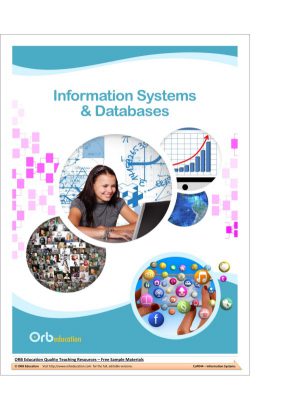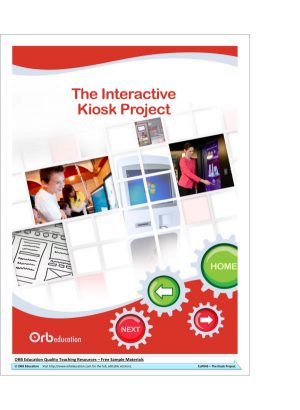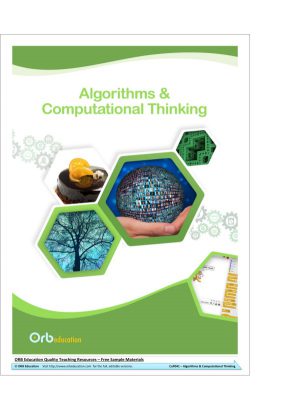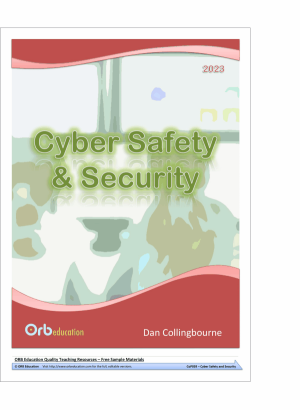Curriculum Information
Australian Curriculum V9.0 (2024)
AC V9.0 (Recap 5-6): · investigate the main internal components of common digital systems and their function (AC9TDI6K01)
AC V9.0 (Recap 5-6): – explaining how digital systems are made up of parts that perform specific functions, for example the processor controls the tablet, performs calculations and manipulates data
AC V9.0 (Recap 5-6): – exploring how the central processing unit (CPU), memory and input/output components work together to perform a simple calculation
AC V9.0 (7-8): · explain how hardware specifications affect performance and select appropriate hardware for particular tasks and workloads (AC9TDI8K01)
AC V9.0 (7-8): – explaining how hardware specifications affect what, and how quickly, a digital system can perform tasks, for example how different bandwidth networks affect download speed and lag or how much random access memory (RAM) is needed for multimedia authoring
AC V9.0 (7-8): – selecting appropriate hardware for particular tasks, for example choosing a powerful graphics card for computer gaming or large external storage for video editing
AC V9.0 (Recap 5-6): – explaining how separate systems can be connected in different ways to exchange data, for example how a laptop can be connected to a network via a cable or radio waves
AC V9.0 (7-8): · investigate how data is transmitted and secured in wired and wireless networks including the internet (AC9TDI8K02)
AC V9.0 (Recap 5-6): Securely access and use multiple digital systems and describe their components and how they interact to process and transmit data.
AC V9.0 (Recap 5-6): · examine how digital systems form networks to transmit data (AC9TDI6K02)
AC V9.0 (Recap 5-6): – investigating the main components in a video conferencing system and their functions, for example a telehealth system used by Aboriginal and Torres Strait Islander communities to access ultrasound and other imagery services
AC V9.0 (7-8): Select appropriate hardware for particular tasks, explain how data is transmitted and secured in networks, and identify cyber security threats.
AC V9.0 (Recap 5-6): – investigating the use of satellite phones where mobile phone networks are not available, inaccessible or unreliable, for example many homeland communities of Arnhem Land have limited access to mainstream communication networks
AC V9.0 (Recap 5-6): Examine how data is broken up and sent through networks.
AC V9.0 (7-8): – describing physical networks and comparing their properties, for example the bandwidth, latency and reliability of wired versus wireless networks
AC V9.0 (7-8): – considering how First Nations Australians communities in areas classified as remote often share access to smartphone and internet services, and how the hardware specifications of these devices affect performance, for example where immediate and extended families share and access data through a single smartphone or device
AC V9.0 (Recap 5-6): – describing the way data is structured and transmitted through a network, for example broken up into packets (small pieces) and passed from the source, through multiple devices, to the destination
AC V9.0 (7-8): – explaining how problems occur in network communication and how they can be solved, for example routers can drop packets and how Transmission Control Protocol (TCP) uses acknowledgements to confirm packets have been received
AC V9.0 (7-8): Investigate how data is transmitted via wired and wireless networks and explain the need for encryption to protect and secure data.
AC V9.0 (7-8): Select appropriate hardware for particular tasks, explain how data is transmitted and secured in networks, and identify cyber security threats.
AC V9.0 (7-8): – explaining why cryptography is necessary for securing data, for example transmitting credit card details over the internet
AC V9.0 (7-8): – exploring simple encryption and decryption algorithms, for example ROT13 and XOR
NSW Digital Technologies (Tech Mandatory)
NSW DT(Tech Mand): LS – · recognise that everyday tasks are supported by digital technologies, for example:
– use augmentative and alternative communication aids”
NSW DT(Tech Mand): LS – · recognise digital systems used for everyday purposes, eg assistive technology
NSW DT(Tech Mand): LS – · recognise digital systems used for everyday purposes, eg mobile devices
NSW DT(Tech Mand): – high-powered systems for gaming and computation
NSW DT(Tech Mand): · evaluate the suitability of hardware with particular performance characteristics against the needs of different users, for example: (ACTDIK023)
– energy-efficient systems for travel and productivity
– small and light systems for health monitoring”
NSW DT(Tech Mand): LS – · use digital technologies to communicate
NSW DT(Tech Mand): · explore how data is transmitted and secured in wired, wireless and mobile networks, for example: (ACTDIK023)
NSW DT(Tech Mand): LS – · phone calls
NSW DT(Tech Mand): › identifies how information is communicated by digital systems TELS-8DI
NSW DT(Tech Mand): LS – · recognise that digital technologies can be used to communicate with others
NSW DT(Tech Mand): LS – · recognise that everyday tasks are supported by digital technologies, for example:
NSW DT(Tech Mand): LS – – money withdrawal
NSW DT(Tech Mand): LS – – online shopping
NSW DT(Tech Mand): LS – · use digital technologies to communicate, for example:
– use mobile devices to send messages”
NSW DT(Tech Mand): TE4-7DI explains how data is represented in digital systems and transmitted in networks
NSW DT(Tech Mand): – how transmission media affects the reliability and speed of data transfer
NSW DT(Tech Mand): – how data is transferred over the internet with TCP/IP
NSW DT(Tech Mand): – how data is secured in wireless networks with WPA
NSW Computing Technology (2024)
NSW Comp Tech (2024) -UE: ¤ explains how data is stored, transmitted and secured in digital systems and how information is communicated in a range of contexts CT5-DAT-01:
NSW Comp Tech (2024) -Net: ¤ Describe inputs, storage, processes and outputs in connecting people and systems:
NSW Comp Tech (2024) -UE: ¤ Explore how UIs or interactive media have evolved in response to people’s needs and opportunities: Development of input and output technology.
NSW Comp Tech (2024) -Net: ¤ understands how innovation, enterprise and automation have inspired the evolution of computing technology CT5-EVL-01:
NSW Comp Tech (2024) -Net: ¤ Explore careers in connecting people and systems:
NSW Comp Tech (2024) -Net: ¤ Describe common network hardware for wired, wireless and mobile networks:
By Resource
0. Checklist
1. Wordlist
2. Digital Systems
AC V9.0 (Recap 5-6): · investigate the main internal components of common digital systems and their function (AC9TDI6K01)NSW Comp Tech (2024) -UE: ¤ explains how data is stored, transmitted and secured in digital systems and how information is communicated in a range of contexts CT5-DAT-01:
AC V9.0 (Recap 5-6): – explaining how digital systems are made up of parts that perform specific functions, for example the processor controls the tablet, performs calculations and manipulates data
3. Inputs and Outputs
NSW Comp Tech (2024) -Net: ¤ Describe inputs, storage, processes and outputs in connecting people and systems:
NSW DT(Tech Mand): LS – · recognise that everyday tasks are supported by digital technologies, for example:
– use augmentative and alternative communication aidsNSW Comp Tech (2024) -UE: ¤ Explore how UIs or interactive media have evolved in response to people’s needs and opportunities: Development of input and output technology.
NSW DT(Tech Mand): LS – · recognise digital systems used for everyday purposes, eg assistive technology
4. Working Together
AC V9.0 (Recap 5-6): – exploring how the central processing unit (CPU), memory and input/output components work together to perform a simple calculation
5. Types of Computers
NSW DT(Tech Mand): LS – · recognise digital systems used for everyday purposes, eg mobile devices
NSW DT(Tech Mand): – high-powered systems for gaming and computation
6. The Evolution of Technology
7. System Performance
AC V9.0 (7-8): · explain how hardware specifications affect performance and select appropriate hardware for particular tasks and workloads (AC9TDI8K01)NSW DT(Tech Mand): · evaluate the suitability of hardware with particular performance characteristics against the needs of different users, for example: (ACTDIK023)
– energy-efficient systems for travel and productivity
– small and light systems for health monitoring
AC V9.0 (7-8): – explaining how hardware specifications affect what, and how quickly, a digital system can perform tasks, for example how different bandwidth networks affect download speed and lag or how much random access memory (RAM) is needed for multimedia authoring
AC V9.0 (7-8): – selecting appropriate hardware for particular tasks, for example choosing a powerful graphics card for computer gaming or large external storage for video editing
8. Connecting Systems
AC V9.0 (Recap 5-6): – explaining how separate systems can be connected in different ways to exchange data, for example how a laptop can be connected to a network via a cable or radio wavesNSW DT(Tech Mand): LS – · use digital technologies to communicate
AC V9.0 (7-8): · investigate how data is transmitted and secured in wired and wireless networks including the internet (AC9TDI8K02)NSW DT(Tech Mand): · explore how data is transmitted and secured in wired, wireless and mobile networks, for example: (ACTDIK023)
NSW DT(Tech Mand): LS – · phone calls
9. Building Networks
AC V9.0 (Recap 5-6): Securely access and use multiple digital systems and describe their components and how they interact to process and transmit data. NSW DT(Tech Mand): › identifies how information is communicated by digital systems TELS-8DI
AC V9.0 (Recap 5-6): · examine how digital systems form networks to transmit data (AC9TDI6K02)
10. Using Networks
AC V9.0 (Recap 5-6): – investigating the main components in a video conferencing system and their functions, for example a telehealth system used by Aboriginal and Torres Strait Islander communities to access ultrasound and other imagery servicesNSW DT(Tech Mand): LS – · recognise that digital technologies can be used to communicate with othersNSW Comp Tech (2024) -Net: ¤ Explore careers in connecting people and systems:
NSW DT(Tech Mand): LS – · recognise that everyday tasks are supported by digital technologies, for example:
NSW DT(Tech Mand): LS – – money withdrawal
NSW DT(Tech Mand): LS – – online shopping
NSW DT(Tech Mand): LS – · use digital technologies to communicate, for example:
– use mobile devices to send messages
11. Network Design
AC V9.0 (7-8): Select appropriate hardware for particular tasks, explain how data is transmitted and secured in networks, and identify cyber security threats.NSW DT(Tech Mand): TE4-7DI explains how data is represented in digital systems and transmitted in networksNSW Comp Tech (2024) -Net: ¤ Describe common network hardware for wired, wireless and mobile networks:
AC V9.0 (Recap 5-6): – investigating the use of satellite phones where mobile phone networks are not available, inaccessible or unreliable, for example many homeland communities of Arnhem Land have limited access to mainstream communication networks
12. Network Speed
AC V9.0 (Recap 5-6): Examine how data is broken up and sent through networks.
AC V9.0 (7-8): – describing physical networks and comparing their properties, for example the bandwidth, latency and reliability of wired versus wireless networksNSW DT(Tech Mand): – how transmission media affects the reliability and speed of data transfer
AC V9.0 (7-8): – considering how First Nations Australians communities in areas classified as remote often share access to smartphone and internet services, and how the hardware specifications of these devices affect performance, for example where immediate and extended families share and access data through a single smartphone or device
13. Packets and Protocols
AC V9.0 (Recap 5-6): – describing the way data is structured and transmitted through a network, for example broken up into packets (small pieces) and passed from the source, through multiple devices, to the destination
AC V9.0 (7-8): – explaining how problems occur in network communication and how they can be solved, for example routers can drop packets and how Transmission Control Protocol (TCP) uses acknowledgements to confirm packets have been received
NSW DT(Tech Mand): – how data is transferred over the internet with TCP/IP
14. Network Security
AC V9.0 (7-8): Investigate how data is transmitted via wired and wireless networks and explain the need for encryption to protect and secure data.NSW DT(Tech Mand): – how data is secured in wireless networks with WPANSW Comp Tech (2024) -Net: ¤ Explore how people’s changing expectations and concerns for security and privacy have shaped computer technology
15. Encryption
AC V9.0 (7-8): Select appropriate hardware for particular tasks, explain how data is transmitted and secured in networks, and identify cyber security threats.
AC V9.0 (7-8): – explaining why cryptography is necessary for securing data, for example transmitting credit card details over the internet
AC V9.0 (7-8): – exploring simple encryption and decryption algorithms, for example ROT13 and XOR
16. Encryption Spreadsheets











Reviews
There are no reviews yet.